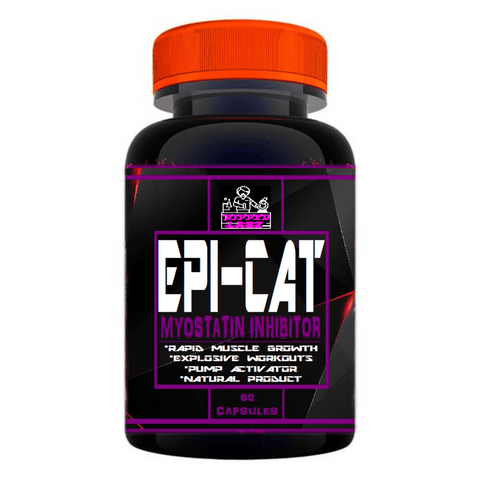*Customers please note:- our bottles and caps have changed to white. Labeling remains the same and unchanged
Ripped Labz EPI-CAT Epicatechin (60 x 500mg capsules)
Benefits of Ripped Labz EPI-CAT:
- Myostatin Inhibition
- Increased Strength
- Increased Follistatin
- Decreases LDL Cholesterol and Inflammation
- Increases in Stamina and Angiogenesis
A recent study has revived the supplement market’s interest in a compound called (-)-epicatechin, a molecule found in chocolate. This molecule is a myostatin inhibitor. Myostatin deficiencies are well known for their biggest side effect: greatly increased muscle mass without the major side-effects associated with anabolic steroids. Hindering myostatin’s actions would be able to replicate this effect.
Myostatin is a myokine, a kind of regulating molecule released by muscles. The ‘opposite’ of myostatin is a myokine called follistatin. Unlike myostatin, which suppresses muscular growth, follistatin indirectly promotes muscle growth because it hinders myostatin signalling.
While there are a few supplements that are known to interact with myostatin signaling (like sulforaphane), none had been tested in the context of human supplementation, until now.
This recent study examined the effects of (-)-epicatechin when supplemented by people.
Should you supplement (-)-epicatechin or eat more chocolate to build muscle? Let’s dissect the study and find out.
This was a proof of concept study in three parts. A proof of concept study is designed to test whether a compound will have the effect researchers hypothesized, as well as determine if further studies are appropriate.
The first part of the study was done in vitro, meaning outside the body in a test tube or petri dish. Scientists assessed muscle cells taken from people of different ages. When people age, their muscles tend to have higher myostatin levels and lower follistatin levels. The in vitro part of the study confirmed this relationship.
The second part of the study was the mouse study. After measuring the myostatin and follistatin levels of old and young mice to confirm the age-related difference, researchers gave the rats 1 mg (-)-epicatechin per kg of body weight, twice a day. Over two weeks, young mice experienced a 15% decrease in myostatin with no change to follistatin. Older mice, meanwhile, experienced an 18% reduction in myostatin and a 30% increase in follistatin.
Two weeks is not enough time to notice any changes in muscle tissue mass, so researchers did not measure it.
In the third part of the study, six middle-aged people supplemented 1 mg of (-)-epicatechin per kg of body weight, twice a day. This translated to about 75 mg of (-)-epicatechin, twice a day, for a total daily dose of 150 mg.
The published study reports that the follistatin to myostatin ratio of the six middle-aged subjects increased +49.2% (follistatin)/ -16.6% (myostatin), which suggests an increase in follistatin levels and a decrease in myostatin levels. However, the exact changes in myostatin and follistatin levels were not reported.
Though a minor (7%) increase in hand grip strength was observed, muscle tissue mass was not measured, and there was no placebo group for comparison.
This study fulfilled the goals of a proof of concept study, because it provides evidence to suggest a possible relationship between (-)-epicatechin, follistatin, and myostatin levels, which can be investigated in future studies.



